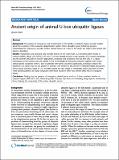Por favor, use este identificador para citar o enlazar a este item:
http://hdl.handle.net/10261/29752COMPARTIR / EXPORTAR:
 SHARE SHARE
 CORE
BASE CORE
BASE
|
|
| Visualizar otros formatos: MARC | Dublin Core | RDF | ORE | MODS | METS | DIDL | DATACITE | |

| Título: | Ancient origin of animal U-box ubiquitin ligases |
Autor: | Marín, Ignacio CSIC ORCID | Fecha de publicación: | 27-oct-2010 | Editor: | BioMed Central | Citación: | BMC Evolutionary Biology 10: 331 (2010) | Resumen: | Background The patterns of emergence and diversification of the families of ubiquitin ligases provide insights about the evolution of the eukaryotic ubiquitination system. U-box ubiquitin ligases (UULs) are proteins characterized by containing a peculiar protein domain known as U box. In this study, the origin of the animal UUL genes is described. Results Phylogenetic and structural data indicate that six of the seven main UUL-encoding genes found in humans (UBE4A, UBE4B, UIP5, PRP19, CHIP and CYC4) were already present in the ancestor of all current metazoans and the seventh (WDSUB1) is found in placozoans, cnidarians and bilaterians. The fact that only 4 - 5 genes orthologous to the human ones are present in the choanoflagellate Monosiga brevicollis suggests that several animal-specific cooptions of the U box to generate new genes occurred. Significantly, Monosiga contains five additional UUL genes that are not present in animals. One of them is also present in distantly-related protozoans. Along animal evolution, losses of UUL-encoding genes are rare, except in nematodes, which lack three of them. These general patterns are highly congruent with those found for other two families (RBR, HECT) of ubiquitin ligases. Conclusions Finding that the patterns of emergence, diversification and loss of three unrelated families of ubiquitin ligases (RBR, HECT and U-box) are parallel indicates that there are underlying, linage-specific evolutionary forces shaping the complexity of the animal ubiquitin system. | Descripción: | 15 pages, 10 figures.-- PMID: 20979629 [PubMed] | Versión del editor: | http://dx.doi.org/10.1186/1471-2148-10-331 | URI: | http://hdl.handle.net/10261/29752 | DOI: | 10.1186/1471-2148-10-331 | E-ISSN: | 1471-2148 |
| Aparece en las colecciones: | (IBV) Artículos |
Ficheros en este ítem:
| Fichero | Descripción | Tamaño | Formato | |
|---|---|---|---|---|
| BMC Evol Biol 010-00331.pdf | 3,78 MB | Adobe PDF |  Visualizar/Abrir |
CORE Recommender
PubMed Central
Citations
16
checked on 24-abr-2024
SCOPUSTM
Citations
24
checked on 19-abr-2024
WEB OF SCIENCETM
Citations
24
checked on 25-feb-2024
Page view(s)
367
checked on 23-abr-2024
Download(s)
270
checked on 23-abr-2024
Google ScholarTM
Check
Altmetric
Altmetric
Artículos relacionados:
NOTA: Los ítems de Digital.CSIC están protegidos por copyright, con todos los derechos reservados, a menos que se indique lo contrario.
